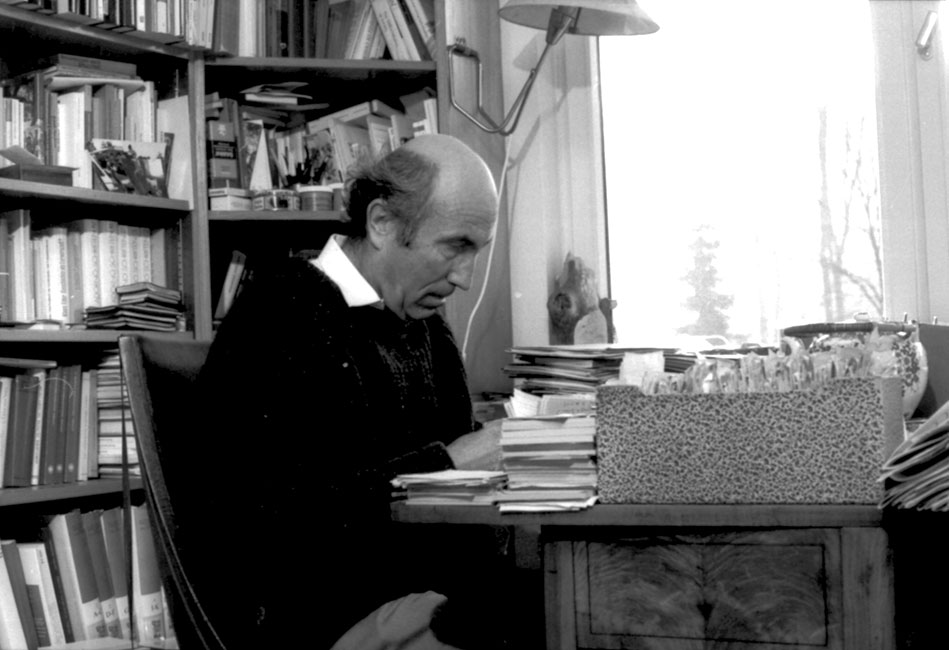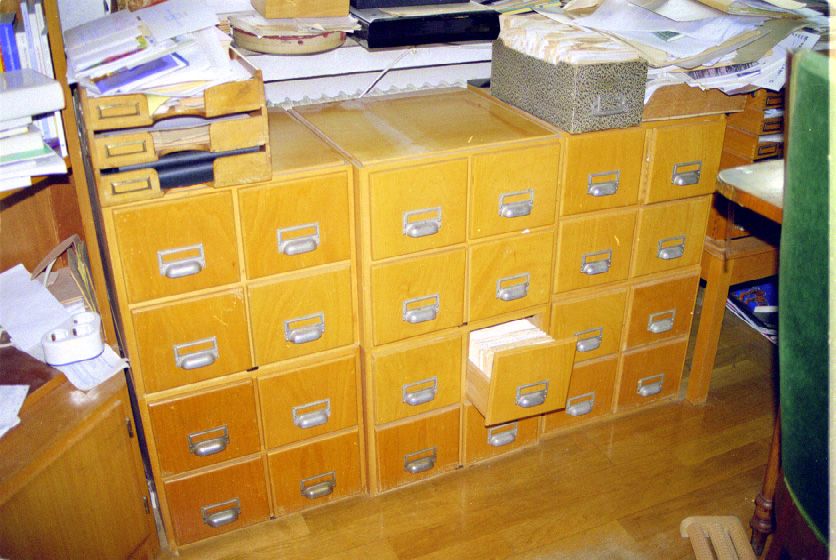Niklas Luhmann's zettelkasten consists of a total of 27 sections/drawers each containing from 2,500 to 3,500 slips.
- ZK1 comprises 7 sections with about 23,000 notes written from about 1952 to 1961
- ZKII comprises 20 sections with approximately 67,000 slips written between 1961 to early 1997.
Sections 15, 16, 17 were part of the beechwood zettelkasten and along with sections 18, 19, and 20 which were stored outside of the main boxes in individual slipcases contain the bibliographic portions of ZKII
Part of section 17 contains some of the index as well as an index of people for ZKII in addition to some other special portions along with the index of keywords, bibliographical slips, and an overview of topics from ZKI.
The primary wooden boxes frequently pictured as "Luhmann's zettelkasten" is comprised of six wooden four-drawer card index filing cabinets which were supplemented by three individual slipcases.
One would suspect the individual slipcases were like the one pictured on his desk here:
 Luhmann zuhause am Zettelkasten (vermutlich Ende der 1970er/Anfang 1980er Jahre)<br />
Copyright Michael Wiegert-Wegener<br />
via Niklas Luhmann Online: die Erschließung seines Nachlasses - Geistes- & Sozialwissenschaften
Luhmann zuhause am Zettelkasten (vermutlich Ende der 1970er/Anfang 1980er Jahre)<br />
Copyright Michael Wiegert-Wegener<br />
via Niklas Luhmann Online: die Erschließung seines Nachlasses - Geistes- & Sozialwissenschaften
The Luhmann archive has a photo of the beechwood portion with 24 drawers and one of the additional slipboxes on top of it:
 (via https://niklas-luhmann-archiv.de/nachlass/zettelkasten)
(via https://niklas-luhmann-archiv.de/nachlass/zettelkasten)
Most of the photos from the museum exhibition and elsewhere only focus on or include the main wooden portion of six cabinets with the 24 drawers.
See also: https://niklas-luhmann-archiv.de/nachlass/zettelkasten
Over the 45 years from 1952 to 1997 this production of approximately 90,000 slips averages out to
45 years * 365 days/year = 16,425 days
90,000 slips / 16,425 days = 5.47 slips per day.
260 working days a year (on average, not accounting for leap years or potential governmental holidays)
45 years x 260 work days/year = 11,700
90,000 slips / 11,700 days = 7.69 slips per day
In a video, Ahrens indicates that Luhmann didn't make notes on weekends, and if true this would revise the count to 7.69 slips per day.
Compare these closer numbers to Ahrens' stated 6 notes per day in How to Take Smart Notes. <br />
See: https://hypothes.is/a/iwrV8hkwEe2vMSdjnwKHXw
I've counted from the start of '52 through all of '97 to get 45 years, but the true amount of time was a bit shorter than this in reality, so the number of days should be slightly smaller.
 Luhmann zuhause am Zettelkasten (vermutlich Ende der 1970er/Anfang 1980er Jahre)<br />
Copyright Michael Wiegert-Wegener<br />
via
Luhmann zuhause am Zettelkasten (vermutlich Ende der 1970er/Anfang 1980er Jahre)<br />
Copyright Michael Wiegert-Wegener<br />
via  (via
(via 





